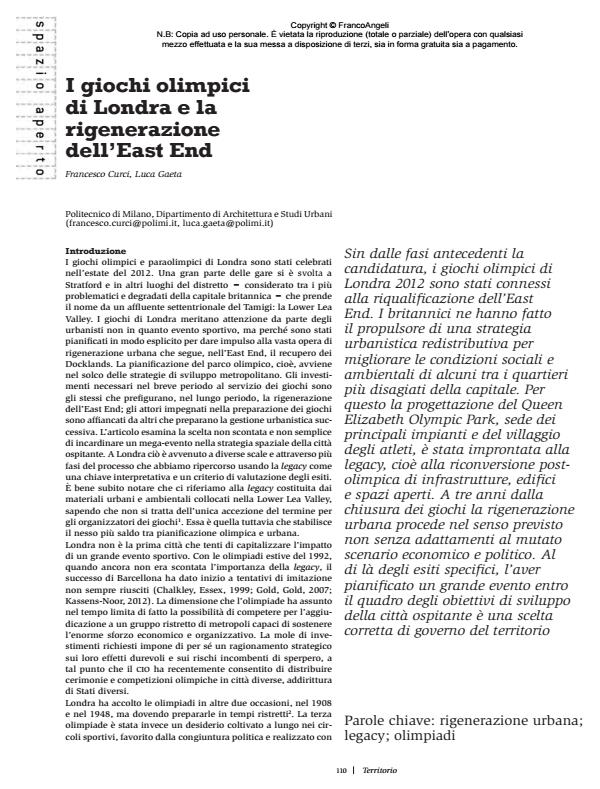I giochi olimpici di Londra e la rigenerazione dell’East End
Titolo Rivista TERRITORIO
Autori/Curatori Francesco Curci, Luca Gaeta
Anno di pubblicazione 2016 Fascicolo 2016/77
Lingua Italiano Numero pagine 10 P. 110-119 Dimensione file 435 KB
DOI 10.3280/TR2016-077018
Il DOI è il codice a barre della proprietà intellettuale: per saperne di più
clicca qui
Qui sotto puoi vedere in anteprima la prima pagina di questo articolo.
Se questo articolo ti interessa, lo puoi acquistare (e scaricare in formato pdf) seguendo le facili indicazioni per acquistare il download credit. Acquista Download Credits per scaricare questo Articolo in formato PDF

FrancoAngeli è membro della Publishers International Linking Association, Inc (PILA)associazione indipendente e non profit per facilitare (attraverso i servizi tecnologici implementati da CrossRef.org) l’accesso degli studiosi ai contenuti digitali nelle pubblicazioni professionali e scientifiche
Sin dalle fasi antecedenti la candidatura, i giochi olimpici di Londra 2012 sono stati connessi alla riqualificazione dell’East End. I britannici ne hanno fatto il propulsore di una strategia urbanistica redistributiva per migliorare le condizioni sociali e ambientali di alcuni tra i quartieri più disagiati della capitale. Per questo la progettazione del Queen Elizabeth Olympic Park, sede dei principali impianti e del villaggio degli atleti, è stata improntata alla legacy, cioè alla riconversione postolimpica di infrastrutture, edifici e spazi aperti. A tre anni dalla chiusura dei giochi la rigenerazione urbana procede nel senso previsto non senza adattamenti al mutato scenario economico e politico. Al di là degli esiti specifici, l’aver pianificato un grande evento entro il quadro degli obiettivi di sviluppo della città ospitante è una scelta corretta di governo del territorio
Parole chiave:Rigenerazione urbana; legacy; olimpiadi
- Planning Disaster, Successful Event, and Uncertain Future: The Twin Cases of the World Expo 2015 and Innovation District in Milan Luca Gaeta, Stefano Di Vita, in Cahiers de la recherche architecturale, urbaine et paysagère /2021
DOI: 10.4000/craup.8735
Francesco Curci, Luca Gaeta, I giochi olimpici di Londra e la rigenerazione dell’East End in "TERRITORIO" 77/2016, pp 110-119, DOI: 10.3280/TR2016-077018